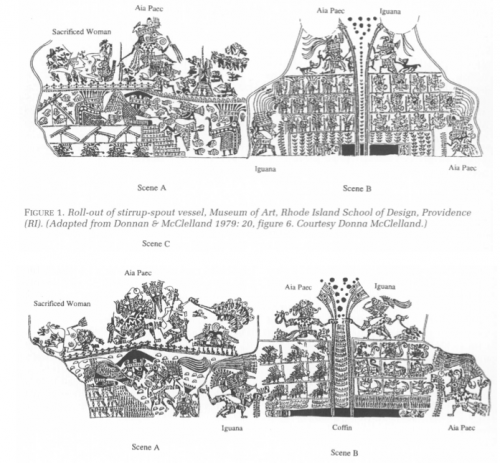Rites of Passage and Mortuary Archaeology
Katy Meyers
Source - http://www.bonesdontlie.com/
One important part of making sense of mortuary archaeology sites is having an understanding of the funeral rituals and practices that occurred there. If we want to interpret the meanings behind specific artifacts within the grave, or determine the reason for the positioning of the body, its necessary to have a grasp on what the emotions, the beliefs and the funeral acts were. One of the ways for understanding the funeral rituals and their archaeologically found behaviors is by looking at it as a rite of passage.

From Morbid Curiosity, Peruvian Funeral Bundle
In 1909, Arnold van Gennep argued that there were tripartite rituals surrounding specific transitional periods in culture known as rites of passage. These occur when the identity of an individual in the group changes and requires re-organization of the structure. Examples include birth, marriage coming of age, and death. The rituals are divided into three stages: separation, transition, and reincorporation. In the first phase, the person separates from their previous identity and society. The liminal or second phase is when they have no specific persona and are in between stages. The final stage occurs when the individual rejoins the society with their new identity. The divisions between groups within a society is important, and crossing the threshold into another requires drastic changes. The purpose of these rituals isn’t always clear. Van Gennep argued that they were aimed at defining and maintaining groups. Radcliffe-Brown argued that it strengthened community ties during times when they had been stressed. Durkheim believed they were an expression of group solidarity and used to control the emotions of those affected. Rites of passage are meant to be a framework for discussing and assessing the various parts of these transitional period, rather than a way to understand universals in human behavior.
Death is the only rite of passage that leaves archaeological traces, allowing us to get a glimpse of the behavior, ideology, and emotional aspects of past cultures. Erica Hill (1998) used mortuary archaeology and iconography from the Moche culture within the rite of passage framework in order to better connect the two pieces of evidence. The Late Moche period was a time of stress due to a lasting drought. It was during this period that the ‘Burial Theme’ began occurring in their iconography. The Burial Theme shows three distinct images: the first is a transfer of conch shells between a deity and the soon to be deceased individual, the second is the funeral of the deceased and their passage to the underworld, and the third is a sacrifice in honor of the deceased. She argues that this is symbolic of the rite of passage. In the first section the soon to be deceased individual acknowledges death and is given shells, separating them from the rest of society. In the second, the dead is mourned and given a funeral. The funeral portrays the deceased as within a rectangular coffin, lying on their back, with a mask and surrounded by shells. It is also in this frame where they make the transition from the world of the living to the world of the dead. Finally, the dead is absent from the frame, and the living remain. The sacrifice is a way to appease the dead and re-establish the bonds of the descendant population.

Hill 1998, Burial Theme
She then connects this iconography to archaeological remains, finding that the predominant burial form in this period was an extended burial in a body fitting rectangular or oval coffin, with the face covered by a mask, and a large offering of shells. Sadly, the first stage of separation or the last stage of sacrifice and incorporation cannot be excavated as easily. However, the shells could be argued to be symbolic of separation. It is likely that the first and final events took place in areas not directly associated with the burial.
Finding all of the stages of the funeral is difficult, if not impossible for archaeology. Cremation may be one of the only ways we can see the other parts of the funeral due to the remains often storing information about the process. For example, in Imperial Roman burials we do not know about the length of the initial separation where the body is put on display for mourning, although we do know from written sources that it depended on the status of the individual. We can infer the duration and heat of the pyre, in some cases the material of the pyre if remains of the wood are recovered with the cremation remains, and we even find evidence of the cremation areas within the cemeteries. All of this helps the interpretation of the transitional period where the body is transformed from a living individual to an ancestor. The final stage is when the funeral rituals end. The dead are placed in their urns within the tombs or columbaria, and are given a new identity among the rest of the ancestors (Graham 2009).
Using the rite of passage as a frame work for understanding mortuary sites in the archaeological record can be a helpful way of dividing the acts around death. It is also valuable in opening up interpretation to look for items meant for the funeral and those meant for the afterlife, and can be beneficial for interpreting purpose behind specific funerary behaviors. However, one must be warned against trying to press all actions, artifacts and behaviors into the mold of the rite of passage. While it is a useful heuristic device, it can restrict interpretation if adhered to too strongly.
Works Cited
Van Gennep 1909. Rites of Passage. University of Chicago Press: Chicago
Hill, Erica 1998. Death as a Rite of Passage: The Iconography of the Moche Burial Theme. Antiquity 72:528-‐38.
Graham, Emma-Jayne 2009. Becoming persons, becoming ancestors. Personhood, memory and the corpse in Roman rituals of social remembrance.In Archaeological Dialogues 16 (1) 51–74.